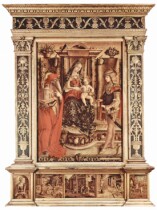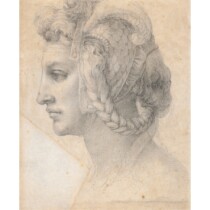Sacred and Profane Love
Two women, apparently drawn from the same model, are posed in a bucolic landscape by a trough, while its water is stirred by a winged Eros. The painting is rich in symbolism and iconography, although there is a lack of consensus amongst critics about its meaning. Even the title of the painting may not be original, as it was not recorded until 1693. The composition of the picture contains elements found in the work of Giorgione, whose style had a significant influence on Titian at the beginning of his career.
The woman to the left is dressed in wedding attire and may represent carnal love and beauty. In contrast, the nude is usually read as spiritual love, a symbol of simplicity and purity. The position of Eros, at the center of the two, therefore, may indicate the point of mediation between spiritual and sexual desires.
The coat of arms on the trough belongs to the family of Niccolò Aurelio, who later became Grand Chancellor of Venice. In May of 1514, he married Laura Bagarotto, daughter of the jurist Bertuccio Bagarotto who had been executed some months before the wedding on charges of betraying the Serenissima Republic. The painting was probably commissioned to celebrate the marriage. It has been suggested that the relief design on the front of the trough symbolizes life and death, inviting the newlywed Laura, to overcome the sorrow for the loss of her father and flourish in marital love, both spiritual and physical. Alternative readings for this design include symbolism for the taming of passions or hidden literary references.
















